An Automated Machine-Learning Approach for Road Pothole Detection Using Smartphone Sensor Data
Abstract
1. Introduction
2. Literature Review
- A pothole-detection approach using smartphones is proposed and verified via experiments, including a series of data-processing methods. A feasible algorithm is developed for calculating the yaw angle of reorientation, and thresholds are used to select potential pothole windows, which are not mentioned in most related works.
- The performance for different feature domains is analyzed and compared with regard to the time required and the pothole-detection accuracy. The strengths of various classifiers are examined, and applicable scenarios for the classifiers are suggested.
- The performance of the proposed method for datasets generated from different types of roads is assessed to evaluate its universality and robustness. The pothole-detection capability of our method is better than that of most previously reported methods.
3. Methodology
3.1. Data Acquisition
3.2. Data Processing
3.2.1. Resampling
3.2.2. Reorientation
3.2.3. Filtering
3.2.4. Labelling
3.2.5. Segmentation
3.3. Feature Extraction
3.4. Machine-Learning Classification
3.5. Evaluation
4. Results and Discussion
4.1. Feature Domain Evaluation
4.2. Classifier Evaluation
4.3. Performance on Different Datasets
4.4. Discussion
5. Conclusions
Author Contributions
Funding
Acknowledgments
Conflicts of Interest
Appendix A
| Algorithm A1. Using the gravity to align the Z-axis of the acceleration data with that of the vehicle. |
| Update α and β every 2 min using the steadiest window (if not found, choose the latest α and β): Extract windows of 6 s using sliding windows with a step of 2 s; Find the steadiest window by choosing the window with the smallest standard deviation; Utilize the mean value of the 3 axes of the selected window to calculate Euler angles α and β via Equations (3) and (4); Complete the transformation for the entire 2-min window using Equation (5); |
| Algorithm A2. Utilizing braking or acceleration events to align the X- and Y-axes of the acceleration data with the vehicle. |
| Update γ every 2 min using a breaking or acceleration event (if not found, choose the latest γ): Extract windows of 6 s using sliding windows with a step of 2 s; Find the most representative window as a breaking or acceleration event: Calculate the ΔV and ΔZ (, ) of each window; A window that satisfies ΔV > 5, ΔZ < 1.5, and ΔV − ΔZ > 4 is treated as an event; If more than one event is found, choose the one with the largest ΔV – ΔZ as the most representative one; |
| If a representative window does not exist, return to the first step; else, find the 5 rows of sample data with the largest horizontal acceleration component and calculate their mean value , ; Calculate γ using Equation (6); Complete the transformation for the entire 2-min window using Equation (7); |
| Algorithm A3. Selecting potential windows. |
| Segment continuous signal into labelled windows of 64 samples using sliding windows with 50% overlap: If the mean speed of a window is <3 m/s, return the first step; else, proceed to the next step; If the sum of the RMS values along the 3 axes of a window is <1.2 m/, return to the first step; else, proceed to the next step; If < 0.25, return to the first step; else, proceed to the next step; Tag the window with GPS coordinates; Tag the window with the ground-truth label: If a window contains no anomaly samples, tag it with the ‘normal’ label; Else, if the window contains >25 anomaly samples, tag it with the corresponding anomaly label (‘pothole’ or ‘transverse’); Else, return to the first step; |
References
- Levin, D. Here to Ruin Your Daily Commute: A Plague of Potholes Jolts the Midwest. The New York Times. 2019. Available online: https://www.nytimes.com/2018/03/25/world/europe/italy-rome-potholes.html (accessed on 25 March 2020).
- Transport Committee, Local roads funding and maintenance: Filling the gap. 2019. Available online: https://publications.parliament.uk/pa/cm201719/cmselect/cmtrans/1486/full-report.html (accessed on 1 March 2020).
- Gardiner, M. Mapping Potholes by Phone (the West Bank’s Roads Were Smoother). 2020. Available online: https://www.nytimes.com/2020/01/23/business/potholes-app.html (accessed on 23 March 2020).
- Vijay, S.; Arya, K. Low cost-FPGA based system for pothole detection on Indian roads. M-Tech Thesis, Indian Inst. Technol., Bombay, India, July 2006. Available online: https://pdfs.semanticscholar.org/8454/b6d24daeb84e88189e94cefb4a614d5c2859.pdf (accessed on 1 July 2020).
- Buza, E.; Omanovic, S.; Huseinovic, A. Pothole Detection with Image Processing and Spectral Clustering. Recent Adv. Comput. Sci. Netw. Pothole 2013, 2–7. [Google Scholar] [CrossRef]
- Strutu, M.; Stamatescu, G.; Popescu, D. A mobile sensor network based road surface monitoring system. In Proceedings of the 2013 17th International Conference on System Theory, Control and Computing (ICSTCC), Sinaia, Romania, 11–13 October 2013; pp. 630–634. [Google Scholar] [CrossRef]
- Astarita, V.; Caruso, M.V.; Danieli, G.; Festa, D.C.; Giofrè, V.P.; Iuele, T.; Vaiana, R. A mobile application for road surface quality control: UNIquALroad. Procedia Soc. Behav. Sci. 2012, 54, 1135–1144. [Google Scholar] [CrossRef]
- Li, X.; Goldberg, D.W. Toward a mobile crowdsensing system for road surface assessment. Comput. Environ. Urban Syst. 2018, 69, 51–62. [Google Scholar] [CrossRef]
- Yan, W.Y.; Yuan, X.X. A low-cost video-based pavement distress screening system for low-volume roads. J. Intell. Transp. Syst. 2018, 22, 376–389. [Google Scholar] [CrossRef]
- Maeda, H.; Sekimoto, Y.; Seto, T.; Kashiyama, T.; Omata, H. Road damage detection using deep neural networks with images captured through a smartphone. Comput. Aided Civ. Infrastruct. Eng. 2018, 33, 1127–1141. [Google Scholar] [CrossRef]
- Ochoa-Ruiz, G.; Angulo-Murillo, A.A.; Ochoa-Zezzatti, A.; Aguilar-Lobo, L.M.; Vega-Fernández, J.A.; Natraj, S. An asphalt damage dataset and detection system based on retinanet for road conditions assessment. Appl. Sci. 2020, 10, 3974. [Google Scholar] [CrossRef]
- Sattar, S.; Li, S.; Chapman, M. Road surface monitoring using smartphone sensors: A review. Sensors 2018, 18, 3845. [Google Scholar] [CrossRef]
- Mohan, P.; Padmanabhan, V.N.; Ramjee, R. Nericell-Using mobile smartphones for rich monitoring of road and traffic conditions. In Proceedings of the 6th ACM conference on Embedded network sensor systems, Raleigh, NC, USA, 5–7 November 2008; pp. 357–358. [Google Scholar] [CrossRef]
- Mednis, A.; Strazdins, G.; Zviedris, R. Real Time Pothole Detection using Android Smartphones with Accelerometers Research domain Road infrastructure as blood vessels. In Proceedings of the 2011 International Conference on Distributed Computing in Sensor Systems and Workshops (DCOSS), Barcelona, Spain, 27–29 June 2011. [Google Scholar]
- Sabir, N.; Memon, A.A.; Shaikh, F.K. Threshold based efficient road monitoring system using crowdsourcing approach. Wirel. Pers. Commun. 2019, 106, 2407–2425. [Google Scholar] [CrossRef]
- Singh, G.; Bansal, D.; Sofat, S.; Aggarwal, N. Smart patrolling: An efficient road surface monitoring using smartphone sensors and crowdsourcing. Pervasive Mob. Comput. 2017, 40, 71–88. [Google Scholar] [CrossRef]
- Eriksson, J.; Girod, L.; Hull, B.; Newton, R.; Madden, S.; Balakrishnan, H. The pothole patrol: Using a mobile sensor network for road surface monitoring. In Proceedings of the 6th international conference on Mobile Systems, Applications, and Services, Breckenridge, CO, USA, 17–20 June 2008; pp. 29–39. [Google Scholar] [CrossRef]
- Nguyen, V.K.; Renault, É.; Ha, V.H. Road anomaly detection using smartphone: A brief analysis. In Proceedings of the MSPN: International Conference on Mobile, Secure, and Programmable Networking, Paris, France, 18–20 June 2018. [Google Scholar] [CrossRef]
- Perttunen, M.; Mazhelis, O.; Cong, F.; Ristaniemi, T.; Riekki, J. Distributed road surface condition monitoring. In Proceedings of the UIC: International Conference on Ubiquitous Intelligence and Computing, Banff, AB, Canada, 2–4 September 2011. [Google Scholar] [CrossRef]
- Seraj, F.; van der Zwaag, B.J.; Dilo, A.; Luarasi, T.; Havinga, P. Roads: A road pavement monitoring system for anomaly detection using smart phones. In Proceedings of the Big Data Analytics in the Social and Ubiquitous Context, Nancy, France, 15 September 2016. [Google Scholar] [CrossRef]
- Silva, N.; Soares, J.; Shah, V.; Santos, M.Y.; Rodrigues, H. Anomaly detection in roads with a data mining approach. Procedia Comput. Sci. 2017, 121, 415–422. [Google Scholar] [CrossRef]
- Varona, B.; Monteserin, A.; Teyseyre, A. A deep learning approach to automatic road surface monitoring and pothole detection. Pers. Ubiquitous Comput. 2019. [Google Scholar] [CrossRef]
- Lepine, J.; Rouillard, V.; Sek, M. Evaluation of machine learning algorithms for detection of road induced shocks buried in vehicle vibration signals. Proc. Inst. Mech. Eng. Part D J. Automob. Eng. 2019, 233, 935–947. [Google Scholar] [CrossRef]
- Basavaraju, A.; Du, J.; Zhou, F.; Ji, J. A machine learning approach to road surface anomaly assessment using smartphone sensors. IEEE Sens. J. 2020, 20, 2635–2647. [Google Scholar] [CrossRef]
- Li, X.; Huo, D.; Goldberg, D.W.; Chu, T.; Yin, Z.; Hammond, T. Embracing crowdsensing: An enhanced mobile sensing solution for road anomaly detection. ISPRS Int. J. Geo-Inf. 2019, 8, 412. [Google Scholar] [CrossRef]
- Google. Firebase. Available online: https://firebase.google.com/ (accessed on 3 July 2019).
- SciPy.org. The Scipy Lib. 2020. Available online: https://www.scipy.org/ (accessed on 10 April 2020).
- Wikipedia Euler Angles. Available online: https://en.wikipedia.org/wiki/Euler_angles (accessed on 13 December 2019).
- Liem, S.; Poeze, E. Aligning the cOordinate Systems of Accelerometer and Vehicle. 2019. Available online: https://viriciti.com/blog/automatic-datahub-orientation/ (accessed on 17 December 2019).
- Khalid, S.; Khalil, T.; Nasreen, S. A survey of feature selection and feature extraction techniques in machine learning. Sci. Inf. Conf. 2014. [Google Scholar] [CrossRef]
- Roh, Y.; Heo, G.; Whang, S.E.; Member, S. A Survey on Data Collection for Machine Learning: A Big Data–AI Integration Perspective. IEEE Trans. Knowl. Data Eng. 2019, 1–20. [Google Scholar] [CrossRef]
- Zhao, W.; Bhushan, A.; Santamaria, A.D.; Simon, M.G.; Davis, C.E. Machine learning: A crucial tool for sensor design. Algorithms 2008, 1, 130–152. [Google Scholar] [CrossRef]
- Taspinar, A. A Guide for Using the Wavelet Transform in Machine Learning. 2018. Available online: http://ataspinar.com/2018/12/21/a-guide-for-using-the-wavelet-transform-in-machine-learning/ (accessed on 21 April 2020).
- Taspinar, A. Machine Learning with Signal Processing Techniques. 2018. Available online: http://ataspinar.com/2018/04/04/machine-learning-with-signal-processing-techniques/ (accessed on 24 April 2020).
- Oberst, U. The fast Fourier transform. SIAM J. Control Optim. 2007, 46, 496–540. [Google Scholar] [CrossRef]
- Sun, L. Simulation of pavement roughness and IRI based on power spectral density. Math. Comput. Simul. 2002, 61, 77–88. [Google Scholar] [CrossRef]
- Akansu, A.N.; Haddad, R.A.; Caglar, H. Perfect reconstruction binomial qmf-wavelet transform. In Proceedings of the Visual Communications and Image Processing '90, Lausanne, Switzerland, 2–4 October 1990; pp. 609–618. [Google Scholar] [CrossRef]
- Rodrigues, R.S.; Pasin, M.; Kozakevicius, A.; Monego, V. Pothole detection in asphalt: An automated approach to threshold computation based on the haar wavelet transform. In Proceedings of the 2019 IEEE 43rd Annual Computer Software and Applications Conference (COMPSAC), Milwaukee, WI, USA, 15–19 July 2019; pp. 306–315. [Google Scholar] [CrossRef]
- Liu, W.; Fwa, T.F.; Zhao, Z. Wavelet analysis and interpretation of road roughness. J. Transp. Eng. 2005, 131, 120–130. [Google Scholar] [CrossRef]
- Bello-Salau, H.; Aibinu, A.M.; Onumanyi, A.J.; Onwuka, E.N.; Dukiya, J.J.; Ohize, H. New road anomaly detection and characterization algorithm for autonomous vehicles. Appl. Comput. Inform. 2020. [Google Scholar] [CrossRef]
- Griffiths, K.R. An Improved Method for Simulation of Vehicle Vibration Using a Journey Database and Wavelet Analysis for the Pre-Distribution Testing of Packaging. 2020, Volume 1. Available online: https://researchportal.bath.ac.uk/en/studentTheses/an-improved-method-for-simulation-of-vehicle-vibration-using-a-jo (accessed on 30 April 2013).
- Mitchell, T.; Hill, M. Machine Learning Textbook. 1997. Available online: http://www.cs.cmu.edu/~tom/mlbook.html (accessed on 4 April 2019).
- Goodfellow, I.; Bengio, Y.; Courville, A. Deep Learning; MIT Press: Cambridge, MA, USA, 2016. [Google Scholar]
- Scikit-Learn. Logistic Regression. Available online: https://scikit-learn.org/stable/modules/linear_model.html#logistic-regression (accessed on 3 March 2020).
- Scikit-Learn. sklearn.linear_model.LogisticRegression. Available online: https://scikit-learn.org/stable/modules/generated/sklearn.linear_model.LogisticRegression.html (accessed on 16 March 2020).
- Cortes, C.; Vapnik, V.N. Support-vector networks. Mach. Learn. 1995, 20, 273–297. [Google Scholar] [CrossRef]
- Sickit-Learn Support Vector Machines. Available online: https://scikit-learn.org/stable/modules/svm.html#svm-classification (accessed on 14 March 2020).
- Bhoraskar, R.; Vankadhara, N.; Raman, B.; Kulkarni, P. Wolverine: Traffic and road condition estimation using smartphone sensors. In Proceedings of the 2012 Fourth International Conference on Communication Systems and Networks, Bangalore, India, 3–7 January 2012. [Google Scholar] [CrossRef]
- Du, R.; Qiu, G.; Gao, K.; Hu, L.; Liu, L. Abnormal road surface recognition based on smartphone acceleration sensor. Sensors 2020, 20, 451. [Google Scholar] [CrossRef]
- Lepine, J. An optimised machine learning algorithm for detecting shocks in road vehicle vibration. Ph.D. Thesis, Victoria University, Melbourne, Australia, 2016. [Google Scholar]
- Dey, M.R.; Satapathy, U.; Bhanse, P.; Mohanta, B.K.; Jena, D. MagTrack: Detecting Road Surface Condition using Smartphone Sensors and Machine Learning. In Proceedings of the 2019 IEEE Region 10 Conference (TENCON), Kochi, India, 17–20 October 2019; pp. 2485–2489. [Google Scholar] [CrossRef]
- Zheng, Z.; Zhou, M.; Chen, Y.; Huo, M.; Chen, D. Enabling real-time road anomaly detection via mobile edge computing. Int. J. Distrib. Sens. Netw. 2019, 15. [Google Scholar] [CrossRef]
- Abdalla, M.H.; Obit, J.H.; Alfred, R.; Bolongkikit, J. Agent based integer programming framework for solving real-life curriculum-based university course timetabling. In Proceedings of the Computational Science and Technology, Kota Kinabalu, Malaysia, 29–30 August 2018; pp. 29–30. [Google Scholar] [CrossRef]
- Souza, V.M.A.; Giusti, R.; Batista, A.J.L. Asfault: A low-cost system to evaluate pavement conditions in real-time using smartphones and machine learning. Pervasive Mob. Comput. 2018, 51, 121–137. [Google Scholar] [CrossRef]
- Scikit-Learn. sklearn.svm.SVC. Available online: https://scikit-learn.org/stable/modules/generated/sklearn.svm.SVC.html (accessed on 3 March 2020).
- Ho, T.K. Random decision forests. In Proceedings of the 3rd International Conference on Document Analysis and Recognition, Montreal, QC, Canada, 14–16 August 1995; pp. 278–282. [Google Scholar] [CrossRef]
- Scikit-Learn. Ensemble Methods. Available online: https://scikit-learn.org/stable/modules/ensemble.html#forest (accessed on 4 May 2020).
- Scikit-Learn Sklearn.ensemble.RandomForestClassifier. Available online: https://scikit-learn.org/stable/modules/generated/sklearn.ensemble.RandomForestClassifier.html (accessed on 5 May 2020).
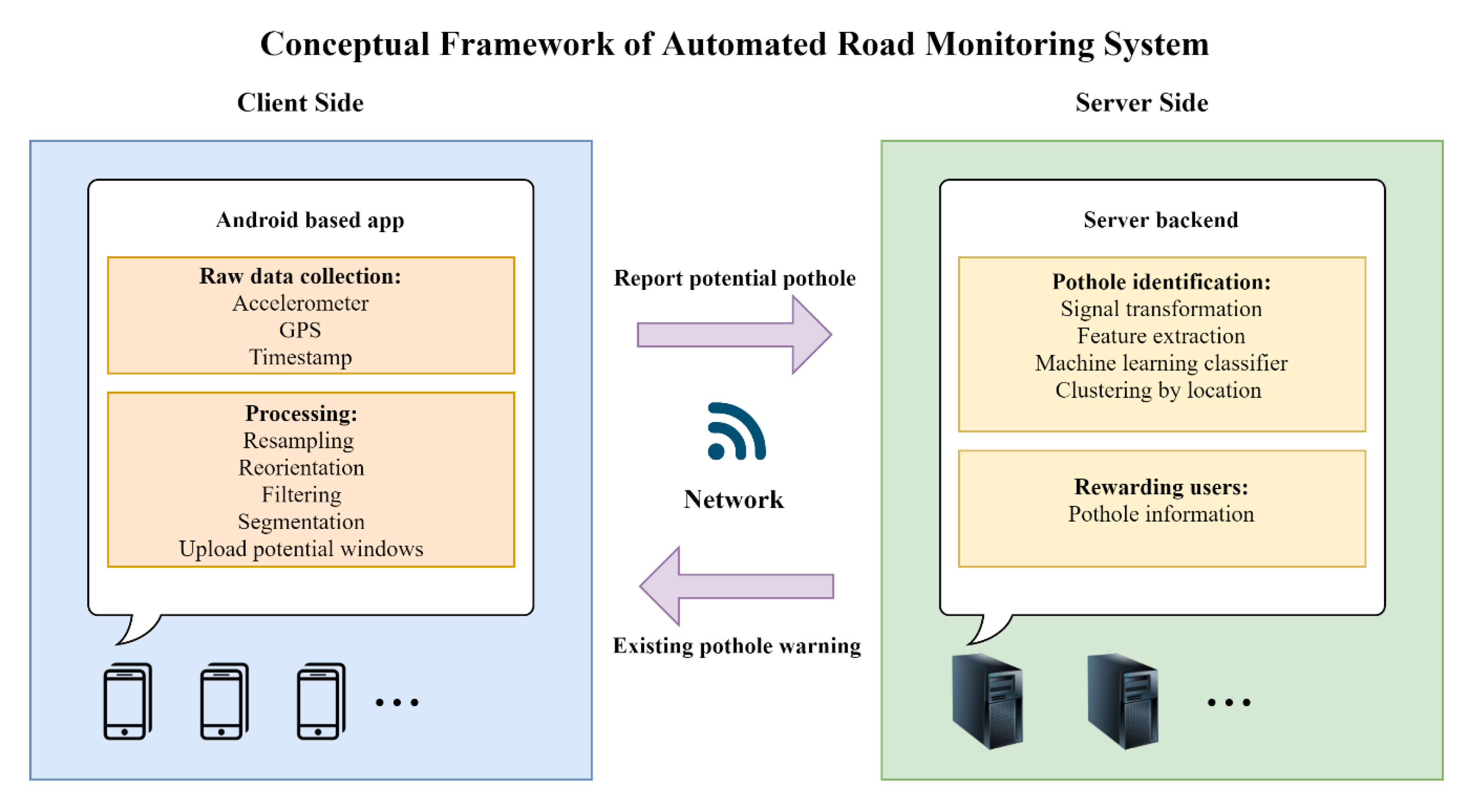
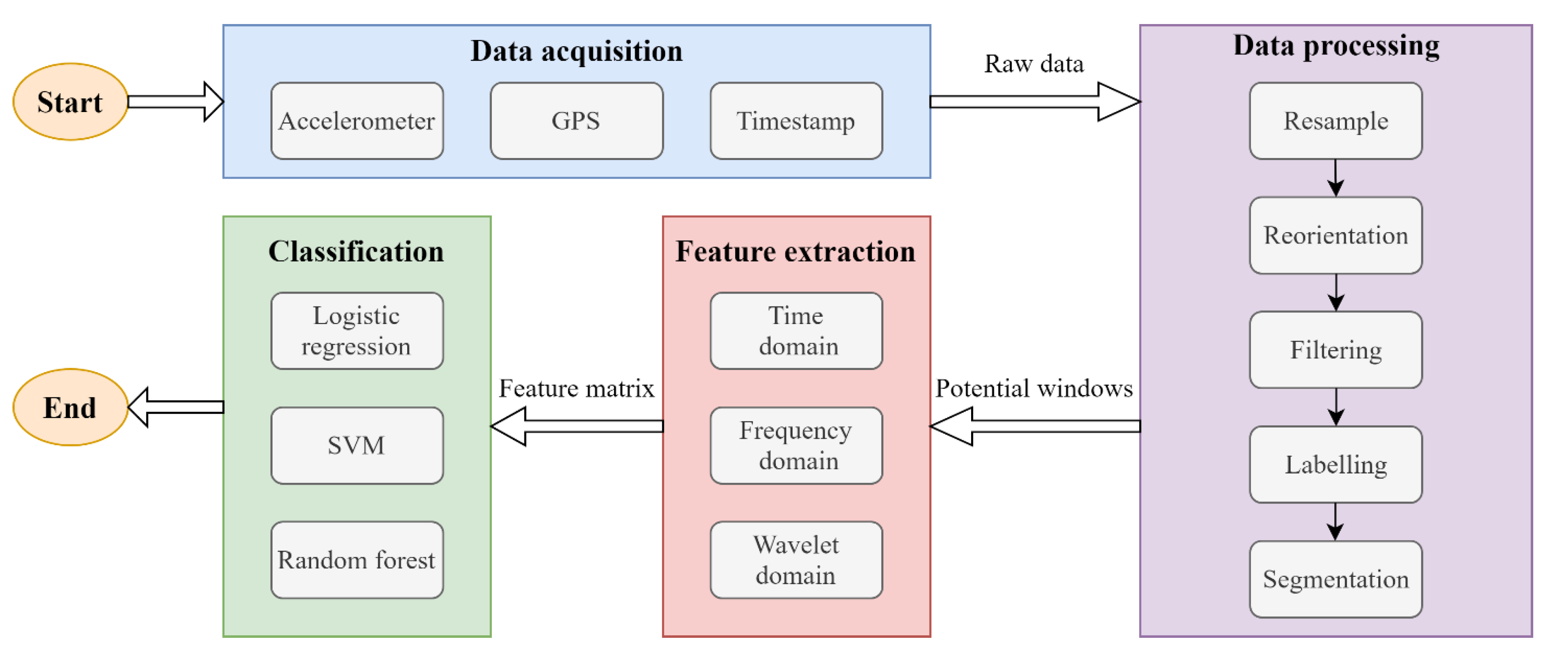
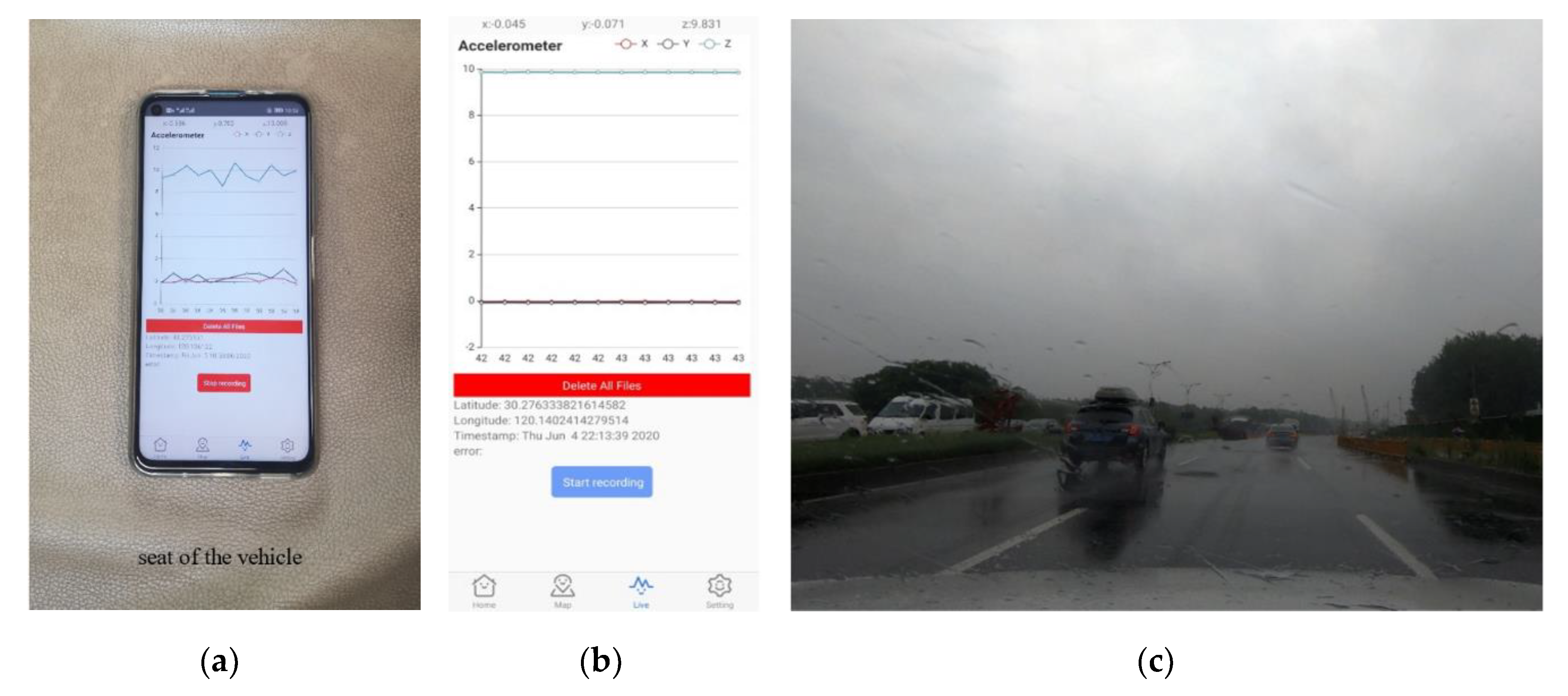
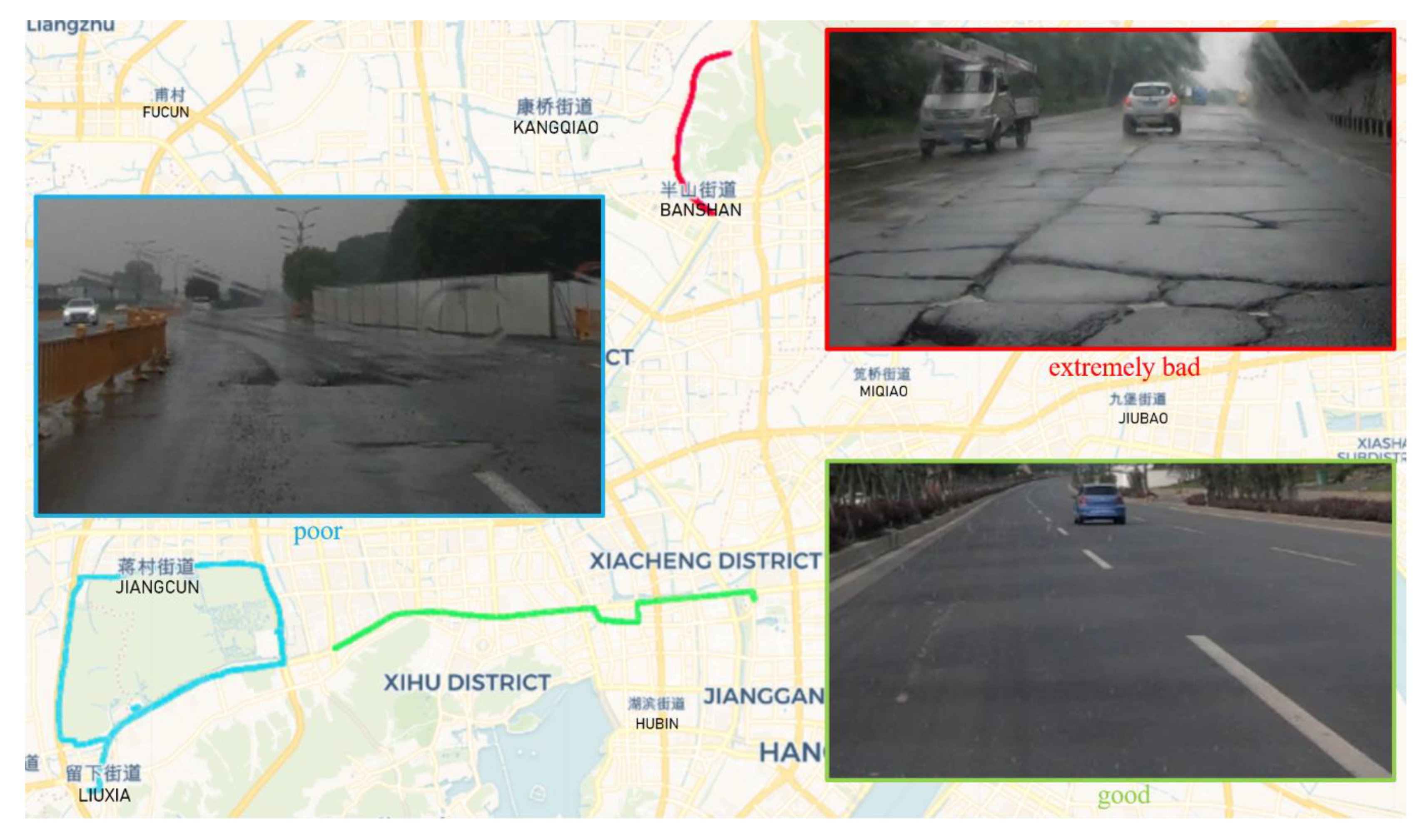
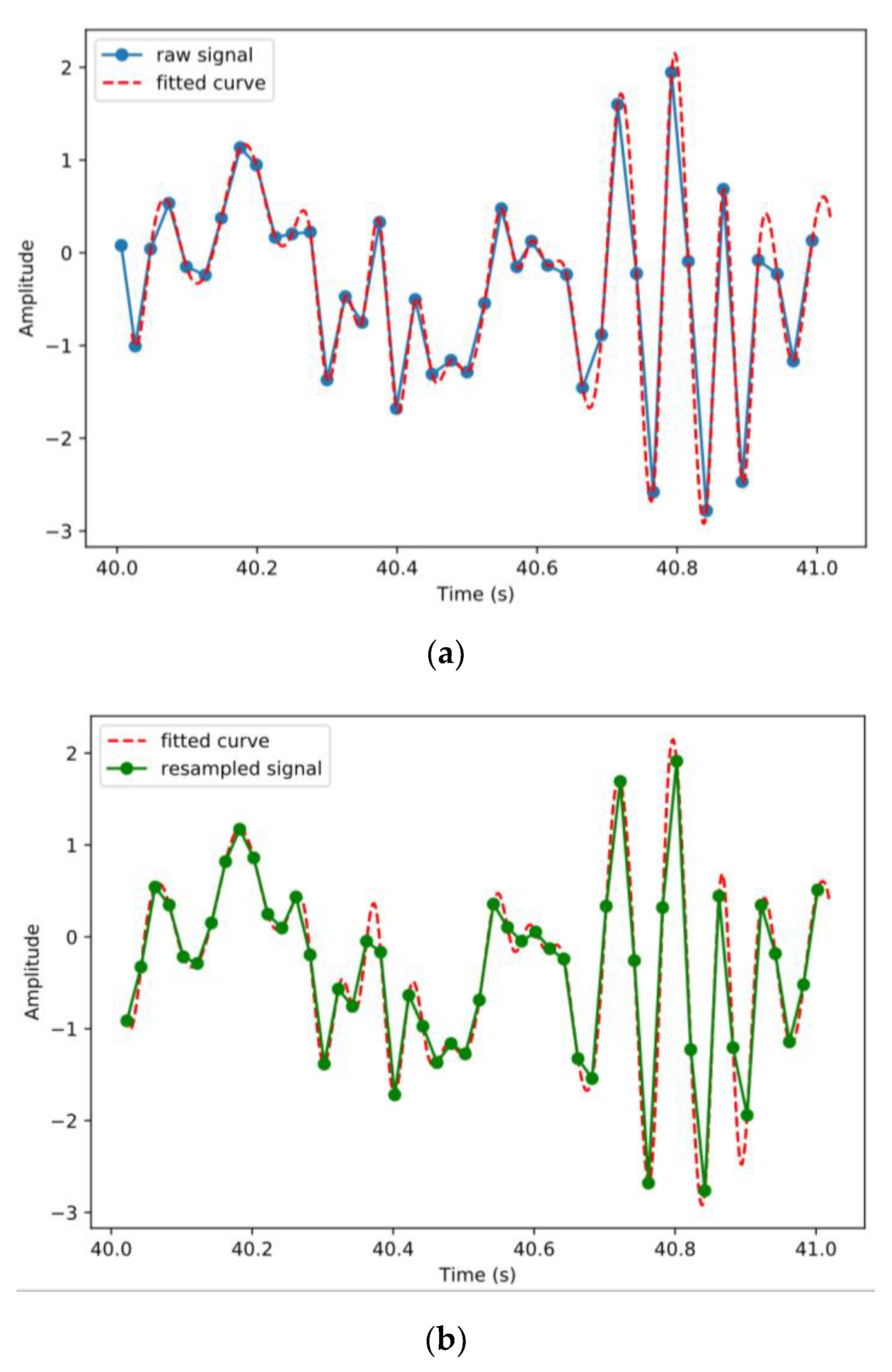

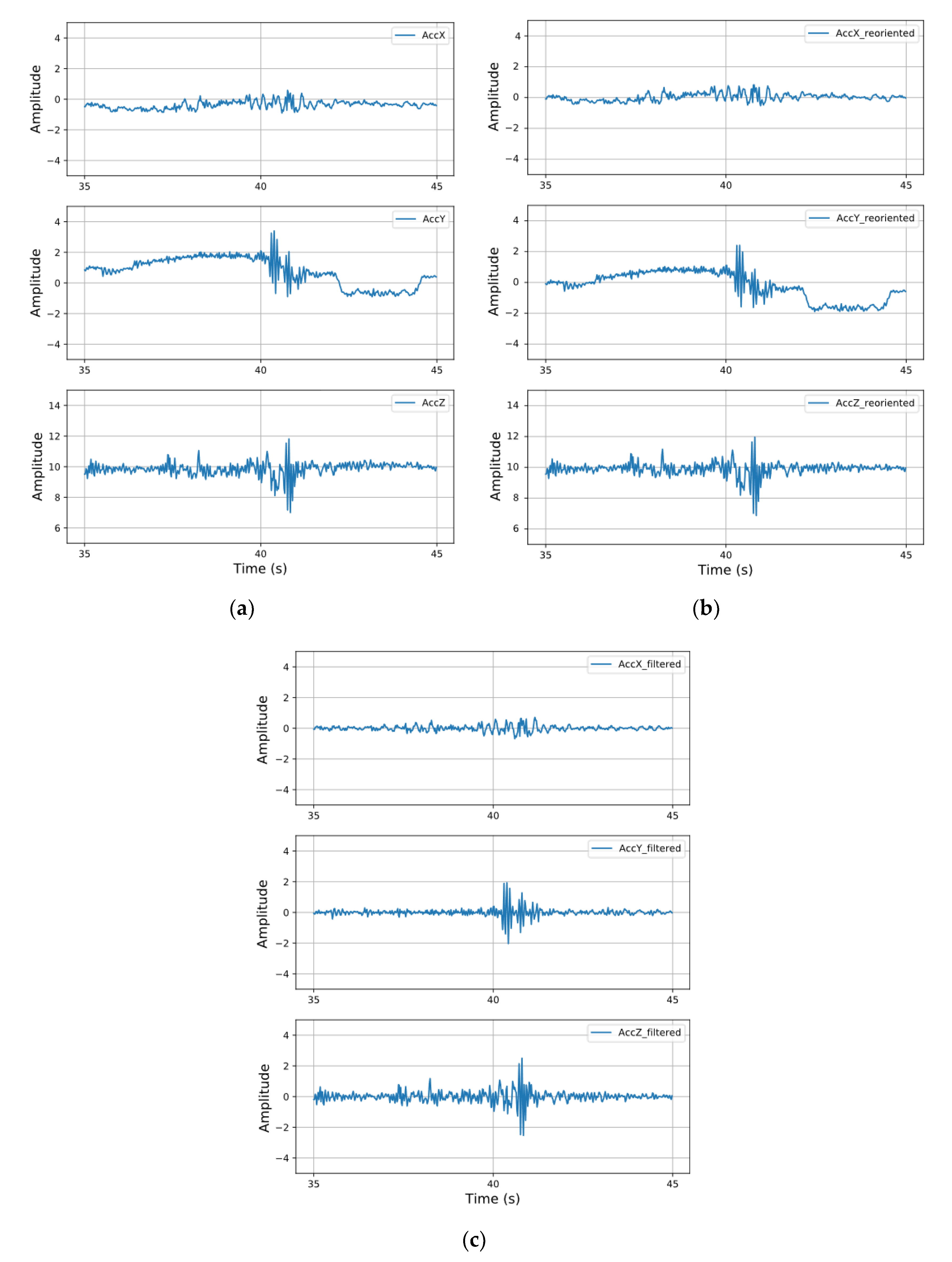




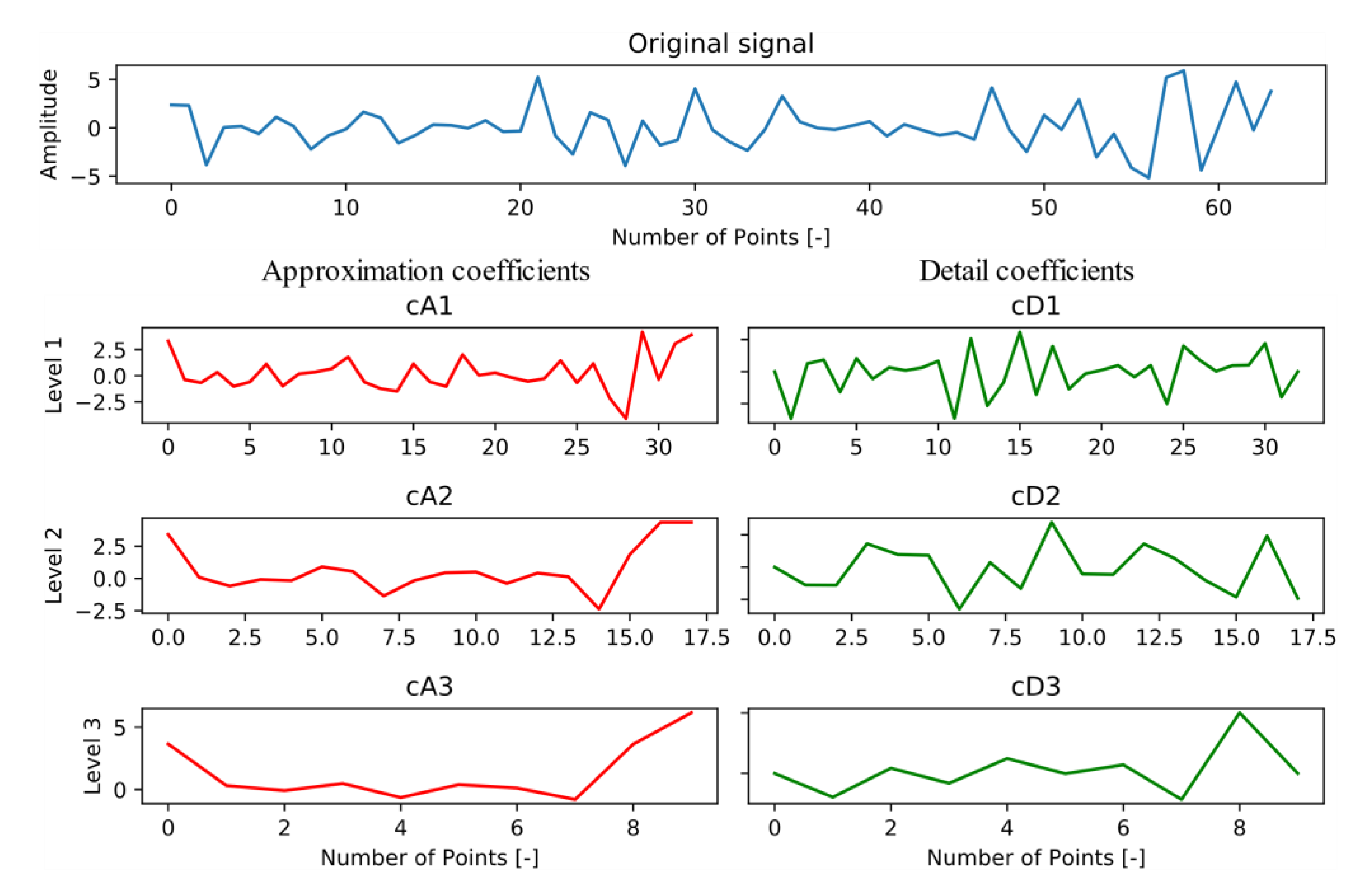
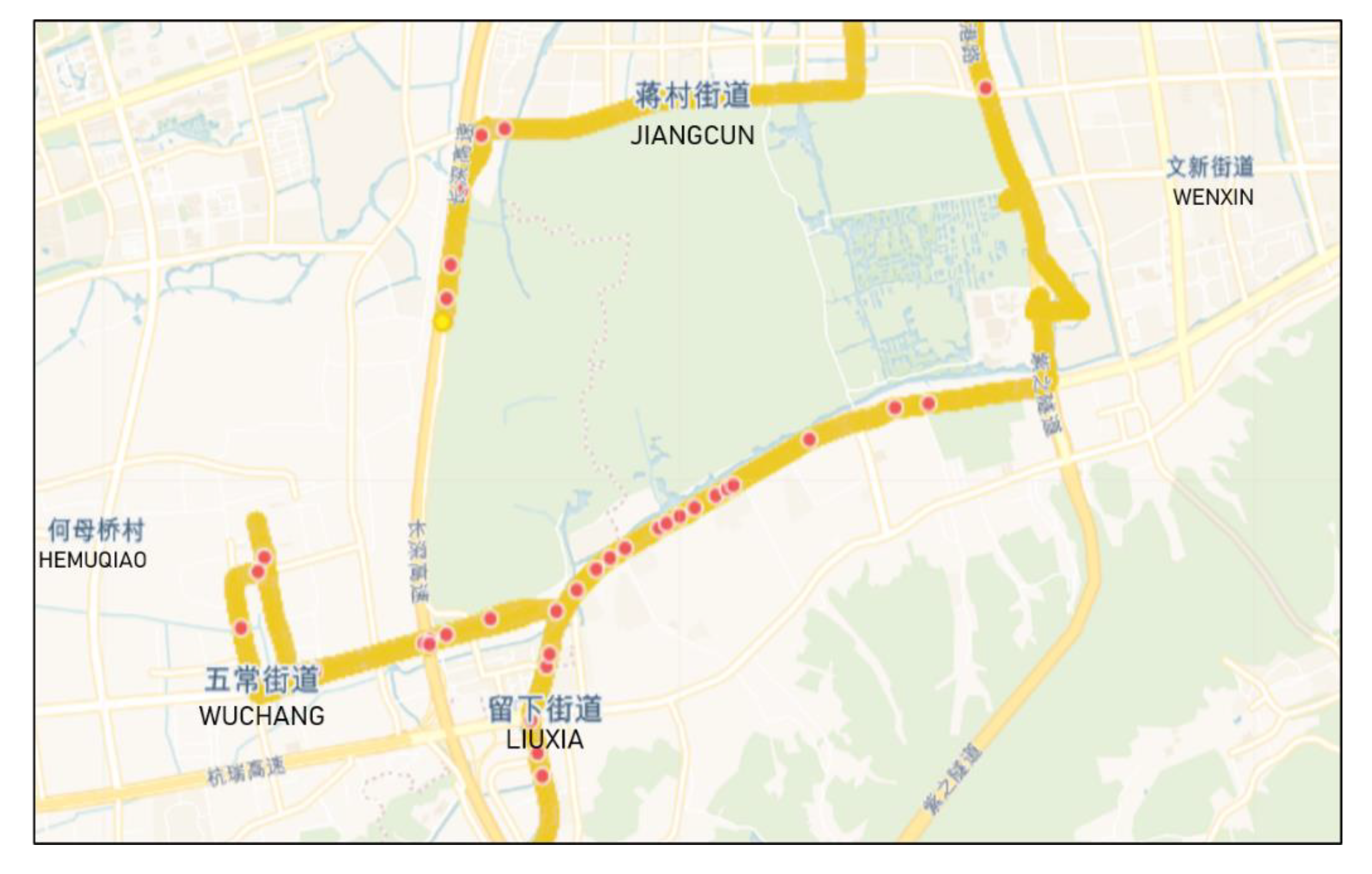
| Road Type | Road Quality | Distance (km) |
|---|---|---|
| National motorway roads | Good | 51.8 |
| Urban roads | Poor | 29.4 |
| Suburban roads | Extremely bad | 25.7 |
| Datasets | Number of Normal Windows | Number of Pothole Windows | Number of Transverse Windows | Total Number of Windows |
|---|---|---|---|---|
| Poor | 817 | 69 | 13 | 899 |
| Bad | 2784 | 405 | 0 | 3189 |
| All (poor and bad) | 3061 | 474 | 13 | 4088 |
| Features | Number of Features for Each Window | Time Required (ms) | Precision | Recall | F1-Score | |
|---|---|---|---|---|---|---|
| Time domain | 36 | 2.50 | 0.878 | 0.741 | 0.804 | |
| Frequency domain | 90 | 2.27 | 0.884 | 0.724 | 0.796 | |
| Time and frequency domain | 126 | 4.77 | 0.885 | 0.750 | 0.812 | |
| Wavelet domain | Reverse biorthogonal 3.1 | 144 | 12.06 | 0.881 | 0.739 | 0.804 |
| Haar | 17.05 | 0.883 | 0.736 | 0.803 | ||
| Symlets 5 | 7.49 | 0.871 | 0.727 | 0.792 | ||
| Daubechies 6 | 7.51 | 0.876 | 0.713 | 0.786 | ||
| Daubechies 10 (db10) | 5.09 | 0.879 | 0.735 | 0.801 | ||
| Classifiers | Accuracy for Training Set | Accuracy for Testing Set | Window Type | Precision | Recall | F1-Score |
|---|---|---|---|---|---|---|
| LR | 0.961 | 0.952 | normal | 0.965 | 0.984 | 0.974 |
| pothole | 0.851 | 0.734 | 0.788 | |||
| SVM | 0.951 | 0.948 | normal | 0.952 | 0.992 | 0.971 |
| pothole | 0.908 | 0.642 | 0.752 | |||
| RF | 0.999 | 0.957 | normal | 0.965 | 0.988 | 0.976 |
| pothole | 0.885 | 0.750 | 0.812 |
| Experiment ID | Training Set | Testing Set | Accuracy on Training Set | Accuracy on Testing Set | Precision | Recall | F1-Score |
|---|---|---|---|---|---|---|---|
| 1 | All | All | 0.999 | 0.957 | 0.885 | 0.750 | 0.812 |
| 2 | Poor | Poor | 0.999 | 0.935 | 0.686 | 0.460 | 0.551 |
| 3 | Bad | Bad | 0.999 | 0.965 | 0.897 | 0.813 | 0.853 |
| 4 | All | Poor | 0.999 | 0.928 | 0.826 | 0.260 | 0.396 |
| 5 | All | Bad | 0.999 | 0.965 | 0.893 | 0.821 | 0.856 |
© 2020 by the authors. Licensee MDPI, Basel, Switzerland. This article is an open access article distributed under the terms and conditions of the Creative Commons Attribution (CC BY) license (http://creativecommons.org/licenses/by/4.0/).
Share and Cite
Wu, C.; Wang, Z.; Hu, S.; Lepine, J.; Na, X.; Ainalis, D.; Stettler, M. An Automated Machine-Learning Approach for Road Pothole Detection Using Smartphone Sensor Data. Sensors 2020, 20, 5564. https://doi.org/10.3390/s20195564
Wu C, Wang Z, Hu S, Lepine J, Na X, Ainalis D, Stettler M. An Automated Machine-Learning Approach for Road Pothole Detection Using Smartphone Sensor Data. Sensors. 2020; 20(19):5564. https://doi.org/10.3390/s20195564
Chicago/Turabian StyleWu, Chao, Zhen Wang, Simon Hu, Julien Lepine, Xiaoxiang Na, Daniel Ainalis, and Marc Stettler. 2020. "An Automated Machine-Learning Approach for Road Pothole Detection Using Smartphone Sensor Data" Sensors 20, no. 19: 5564. https://doi.org/10.3390/s20195564
APA StyleWu, C., Wang, Z., Hu, S., Lepine, J., Na, X., Ainalis, D., & Stettler, M. (2020). An Automated Machine-Learning Approach for Road Pothole Detection Using Smartphone Sensor Data. Sensors, 20(19), 5564. https://doi.org/10.3390/s20195564





